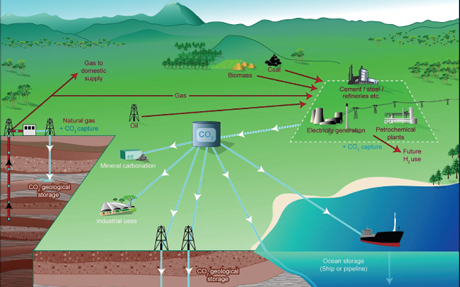The CO2 Community Grid (CO2-CG) project is developing an environment for scientists studying CO2 sequestration. The project-operated infrastructure provides unified access to distributed supercomputers and supports the parallel execution of applications on the base of MUFTE-UG (Multiphase Flow, Transport and Energy Model - Unstructure Grid), a simulation platform for multi-phase multi-component flow simulations. The project is led by Klaus Johannsen (Bergen Center for Computational Science, University of Bergen) and supported by the Nordic Data Grid Facility (NDGF). Other participants include the Institut für Wasserbau at the University of Stuttgart and the Department of Environmental Engineering at the Technical University of Denmark.
Storage of CO2 in deep geological formations is regarded as a promising option for mitigating climate changes caused by anthropogenic greenhouse gases. Many countries are currently investigating different aspects related to this topic. Among other approaches, numerical investigation has proven to be an indispensable tool with which to understand the underlying processes.
The first study supported by the project deals with numerical simulations related to the sequestration of CO2 in deep aquifers. Risk assessments for sequestration scenarios can estimate factors such as leakage rates from aquifers used for sequestration. To determine the critical attributes for potential reservoirs, a parameter study is conducted using a large number of simulations. Typically each simulation uses 64 processor cores and takes between 4 and 48 hours to complete.
How does it work in practice? Scientists access a service computer that acts as a gateway to various computing centres. They prepare the set of simulation inputs and if necessary modify the source code of the application. After a local test run, they can use a single command to run the simulation on a remote Grid resource (computing centre). The CO2-CG environment takes care of packing the necessary input files and source code, shipping them to a suitable resource, compiling and running them, keeping track of the progress and returning the results to a user-defined directory.

The heart of the system is a relational database for storing the information necessary for the jobs. The command-line interface inserts all the necessary parameters for the job into the database, and a separate process then performs Grid submission, execution and progress tracking. Stock NorduGrid Advanced Resource Connector (ARC) middleware is used for Grid access, and ARC application environments called runtime environments provide the platform-specific means to run the simulation on each Grid resource (computing centre). Authentication and authorization is based on an industry-standard X.509 security framework with a dedicated Virtual Organization Management System (VOMS) for managing accounts in the user community.
Results so Far
In the first study, scientists at the University of Stuttgart, Germany, investigated the sensitivity of CO2 distribution in a deep aquifer with respect to various physical parameters. This method is necessary to estimate the risks related to the storage of the greenhouse gas. Within two months the group was able to perform numerical studies, which used approximately 300,000 CPU hours, or about 15% of the resources allocated to the project for 2008. Without the Grid facilities these numerical studies would have taken about three years of execution time.
The Future
A second research group at the University of Bergen, Norway, is now starting to take advantage of these computing facilities. Apart from ease of use, the Grid community will enhance the existing collaboration between groups and will greatly simplify technical exchanges. As international collaborative research becomes both more common and more important, such possibilities for scientific exchange are essential.
The next steps are to enlarge the CO2 community by attracting more research groups and further computing resources. In the longer term, the CO2 Community Grid will be turned into a High-Performance Scientific Computing Grid Community (HPSC-GC) by incorporating other high-performance computing software applications and related scientific groups. In this way the Grid infrastructure will contribute to the broadening of international interdisciplinary research.
Link:
http://www.ndgf.org/ndgfweb/co2_community_grid.html
Please contact:
Josva Kleist
Aalborg University and Nordic
DataGrid Facility, Denmark
E-mail: co2![]() ndgf.org
ndgf.org










